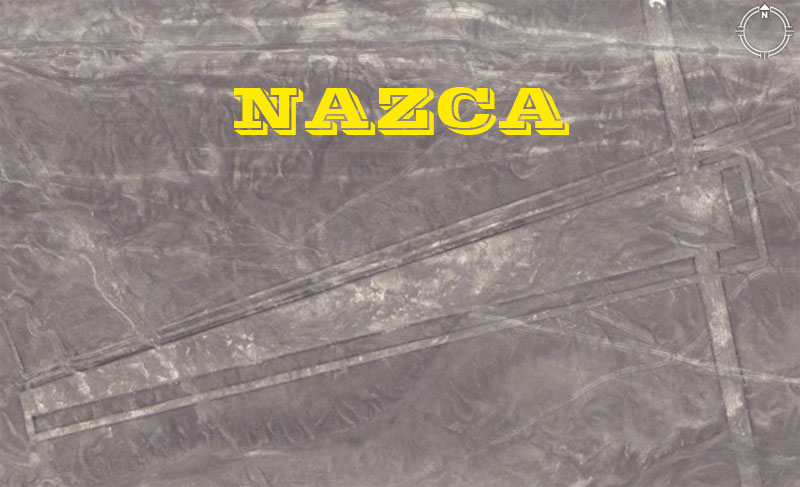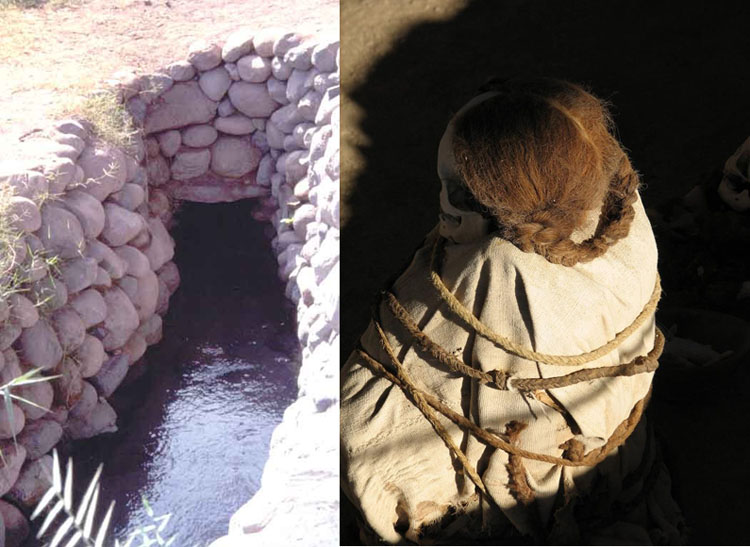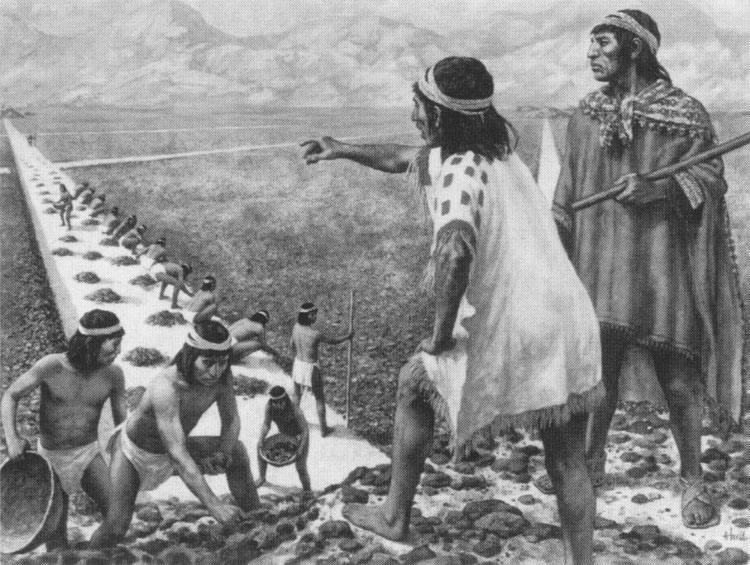
A vast tapestry of geometry, consisting of lines, trapezoids,
rectangles, triangles, glyphs, cairn markers, mounds, etc., is etched into
the desert (pampa) near Nazca, Peru. The intricate design work covers a region
of about 400-square miles, with yet further pockets of similar geometry being
found beyond the main groupings. Some individual lines run uninterrupted for
several miles. The Nazca geometry has survived, mostly intact, for potentially
thousands of years because of the arid, rainless conditions of the high desert,
with the result that the greatest destruction wrought has been in the past
50-years due to mindless vehicle and foot traffic crunching over the lines.
The Nazca lines, as they've come to be known, represent one
of the most baffling mysteries of our age and our expert archaeologists cannot
decipher either their meaning or provide any plausible, rational and acceptable
explanation as to why they were made.
WHY HAVE OUR EXPERTS FAILED?
One would think that in an age of advanced analytical methods,
coupled with high technology surveying tools, the huge desert designs would
constitute a relatively easy puzzle to solve, complicated only by the sheer
volume of lines present. After all, it's only geometry or lines of very measurable
lengths and angles. Don't we get constant Hollywood reminders about the brilliant
military code-breakers, who, since 1940, have been able to crack Japanese
diplomatic codes or the German enigma cipher and, supposedly, to this day,
continue to use complex cryptanalysis to fight cyberterrorism? What about
all of those professors of mathematics, architecture or surveying languishing
in our universities? Couldn't some of them do a bit of number-crunching for
us on their computers?
Interspersed everywhere throughout this vast sea of patterns
at Nazca are recognisable cairn hubs, from which lines emanate outwards like
the spokes of a cartwheel. It's obvious that the cairn humps represented surveying
stations and the lines originating from the cairns provide clearly measurable
beginning and end points in most cases, except in rare circumstances where
ancient flood plain wash has obscured or erased some line ends. Most of the
long-stretching lines have clearly marked intervals or stations along their
lengths, indicating that one is to measure the overall line in individual
segments of varying length. Some of the segment lengths will, very deliberately,
turn to a marginally different degree angle for a certain span or run, which
can then revert back to the more general angle defined within the overall,
segmented line.

Any modern surveyor who gives the Nazca Lines a cursory
glance immediately sees the work of very adept ancient surveyors who were
using the ages-old standard techniques of surveying methodology. The lines
were clearly set out to prescribed and required design-lengths and angles,
in much the same way as a modern surveyor has to shoot lines and then peg-mark
the lengths in accordance with the architect's plan.
Our experts have failed because:
-
Under their all-dominating, classicist-isolationist interpretation
of history, our mainstream experts are not allowed to entertain the fact
that ancient ship building was highly advanced and that the wide oceans
represented much traveled highways to other continents. According to the
all-dominating classicist-isolationist religion that our experts espouse,
anything found at Nazca had to develop locally and in isolation from influences
on other continents.
- Under the requirements of the PC establishment, anything found has to be
the handiwork of ancestors to the present day indigenous population. To suggest
that a totally unrelated civilisation might have created the lines would not
only be "culturally insensitive", but also an affront to regional
honour and a repugnant insult to even suggest. Findings, therefore, have to
be tailored, blurred or fudged to suit a late-era timeframe and the ethnicity
or physical anthropology of the tens-of-thousands of perfectly preserved,
anomalous mummies, of very remote age found at Nazca and surrounding districts,
must never get any honourable mention in mainstream publications, lest that
lead to informed discussion.
- Our experts are very reluctant to factor in the possibility that ancient
people had sophisticated measuring rules, compass devices, surveying tools,
layout techniques, as well as precise weights, volumes and area standards.
Despite the fact that a multitude of huge, perfectly engineered edifices were
built in remote antiquity, apparently it was all done in measurements based
upon the distance from the tips of someone's fingers to the point of the elbow
or across the width of the builder's hand and fingers. Although it is well
known that the many great civilisations of the Mediterranean Basin and Europe
had precise "miles", "stadias", "reeds", "cubits"
or "feet" of very specific and refined length, none of the experts
at Nazca would dare to look at those standards for comparative-analysis. A
vast expanse of water called the Atlantic Ocean separates the two regions
of the world, so, according to the classicist-isolationist religion, none
of the Mediterranean-European standards could possibly have migrated across
that wide, impassible watery ditch to the Americas. Our experts have looked
in vain for a unique, local standard of measurement that might have been used
at Nazca, but couldn't find one.
- According to our experts, the Nazca builders were very superstitious and,
as recently as 550 AD, built the lines for the purpose of appeasing and stroking
the egos of the "gods", in an attempt to get them to send rain during
an extended drought of 40-years duration. The fact that Nazca is about the
driest place on earth, where a small rain every few years causes a sensation
when it happens, or that there has been no significant rainfall there since
the end of the last ice-age, tends to make such a hypotheses laughable in
the extreme. As it turns out, the expansive sprawl of the Andes mountain ranges
just inland, offer a huge catchments area and the Nazca desert region is fed
by a multitude of subterranean springs and wells, making water sources, for
the most part, eternally abundant.

Before Nazca desert region could be made habitable, to
sustain the sizeable population that settled there several thousand years ago,
over 93-miles (150-kilometers) of mostly subterranean aqueducts had to be dug.
Along with these, there were 28 filtration galleries, some of which penetrate
underground over two thirds of a mile into the hard conglomerate deposits and
bring out 25 litres of water per second. The trussed mummy, with the very fine,
auburn-red hair, seen to the right, is typical of the tens of thousands of mummies
that have been found in the region. This reddish hair colour is found on only
a very small percentage of the world's population (about 1-2%). The largest,
present-day concentration of redheads in the world is in the United Kingdom,
where 13-percent of the population has red hair and 40-percent carry the recessive
red gene. The gene is strongly represented in England, Ireland, Wales, Scotland
or amongst the Germanic and Scandinavian tribes, Finns, Russians, Basques and
extending to the most ancient occupants of Egypt in the Eastern Mediterranean
(where the early mummies have red, blond, or other European hues of hair colour)
to the former population of the Canary Islands in the Atlantic (the Gaunche
... where the early mummified people found were ethnic Europeans).
Red hair was very prominent in the ancient Pacific, from
Easter Island (where the giant, long faced statues had "red" top-knot
stones placed on their heads) to New Zealand. In fact, the earliest cave burials
of New Zealand (at the very ends of the Earth) were observed to be Caucasoid
people with red hair. These most ancient New Zealanders also buried their
dead in a trussed, sitting position, alongside personal possessions, in much
the same manner as is found with the Nazca mummies. A huge amount of artefact,
flora and cultural evidence shows a direct link between ancient New Zealand
and Peru. http://en.wikipedia.org/wiki/Red_hair#Geographic_distribution
Well watered, fertile pockets of farmland sit adjacent or very
near to the Nazca lines and ancient people, etching or using the lines, could
return a reasonably short distance each evening to locations offering hospitable
conditions of shelter and sustenance. In essence, the Nazca region would have
been an exceptional centre for an "open-air
university" if the lines were set out for the purpose of
offering tutorials, of some sort, to initiate students.
Based upon the mummy evidence of the region, these tall stature,
Caucasoid, dolichocephalic-cranium, long thin faced people with typical European
hues of multi-coloured hair, built the Nazca aqueducts, settled the area and
made the farms productive. They then undertook the huge task of etching 800
lines and other geometric shapes and glyphs into the desert to indelibly encode
their ages-old sciences, brought with them to the region from the Mediterranean
and Europe.
...as opposed to:

Despite overwhelming evidence to the contrary, large organisations
like National Geographics are obliged to depict the lines as being built by,
what can only be described as, late era Inca Indian look-alikes or those who
subjugated the earlier Caucasoid-European inhabitants and extinguished their
civilisation. The latter Incas were a completely different physical type, with
traits that would be classified as predominantly "Mongoloid" and a
radical departure away from the physiology of the tens of thousands of - Lima
- Paracas - Chapapoyas- Nazca - Chinchoros (Chilean), etc., mummies that have
been found. To show the true builders and what they really looked like would,
apparently, not be "politically-correct" or "racially-sensitive"and
might cause offense, so our school-children have to be subjected to fantasy-propaganda
pseudo-history. Part of the problem for this gross "sin of omission"
might be attributable to nuances of interpretation within the various "code
of ethics" requirements, foisted upon our archaeologists and anthropologists,
who are not allowed to divulge information that is not in keeping with the aggrandizement
and promotion of the present-day, so-called, "indigenous" population.
Our professionals are now so bound-up by delimiting conventions of the United
Nations & UNESCO, etc., that significant observations and discoveries have
to go, largely, unreported and true history cannot be freely disseminated.
There also appears, very strongly, to be a concentrated academic
campaign to erase ancient "European-Caucasoid" historical
traces from the majority of continents or regions around the world where they
once dwelt and built long enduring civilisations. Under the heavily imposed
and vigilantly-monitored rules of the PC establishment, there is an overriding
requirement to force Europeans to be utterly "self-effacing".
Not only are they "not allowed" to know large parts
of their suppressed history, but for Europeans to mention or have pride in the
accomplishments of their very mobilised, distant forebears somehow constitutes
deep-set and despicable"racism", highly-offensive
and repugnant to other ethnicities. While the PC establishment requires that
the accomplishments of all non-European ethnicities be lauded and applauded,
European history is muted, marginalised, dumbed-down or subjected to negatively-derisive
and accusative commentary.
Something that Europeans might consider doing, for the first time
in decades, is to begin researching and writing anew their own "warts-'n-all"
history, based solely upon proper scientific evidence.
Although very definite historical "events"
or historical "facts" are either well documented
or can be proven by clinical scientific procedures, under prevailing postmodernist
wisdom there are no absolutes, only lots of "opinions".
The argument goes that nothing is simply "black or white",
everything is "relative" or some kind of fuzzy grey
fog without any definitive meaning. Chronic liars, control-freaks and spin-doctors
have gotten a lot of mileage out of this deliberately-confused, postmodernist
route to deception.
What has been presented to the world, during the past 50-years
(especially) by politically-motivated experts as somehow representative of European
history, is nothing short of abysmal scholarship at best and sinister scholarship
at its worst.
The big secret appears to be that, quite often, the amazing architectural
or engineering feats and cultural achievements, found scattered across several
continents, were not the product of the present, "indigenous" population
or their direct ancestors. Oftimes, residual archaeological evidences that are
at the heart of present-day national pride need to be reclaimed by their European
owners, whose forebears put the great works in place before they themselves
were extinguished by invaders or camp-followers. This sorry situation of misattributions
is very prevalent from Egypt and the southern Mediterranean coastline to the
Atlantic, then to North, Central and South America and across the entire Pacific
to New Zealand. Other regions within Northern India and parts of Asia are similarly
affected by this unwelcome evidence.
With regards to anomalous, unwanted and out of place human remains
of European physiology being hijacked, then all scientific information about
their true ethnicity coming under the control of unrelated, so-called, "indigenous
groups" and politically motivated control-freaks, the American
Association of Physical Anthropologists complained:
Finally,
is there harm in returning remains to a tribe with no demonstrable cultural
affiliation to those remains? The answer is an emphatic yes. Such repatriations
carry a high probability of error, in the sense that the actual affiliations
may well turn out to be with other groups. Our knowledge of the past is not
static, but keeps improving with time. For example, recent breakthroughs in
DNA analysis mean that many currently unidentifiable remains may well be identifiable
in the future. Thus, premature repatriation to an unaffiliated group runs the
risk, in fact the near certainty, of disenfranchising at least some of the groups
to which those remains are truly affiliated. It also deprives all other groups,
Native American and otherwise, of the opportunity to learn about our shared
humanity from those remains. http://physanth.org/positions/kennewick.html
Let's now go and look at what is really,
very tangibly, on the ground at Nazca:
Continue



